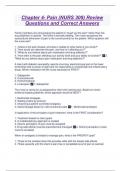Exam (elaborations)
Chapter 4- Pain (NURS 309) Review Questions and Correct Answers
- Course
- Institution
Family members are encouraging the patient to "tough out the pain" rather than risk drug addiction to opioids. The client is stoically abiding. The nurse recognizes the sociocultural dimension of pain is the current priority for the patient. Which question will the nurse ask? 1. "where is the pain...
[Show more]



